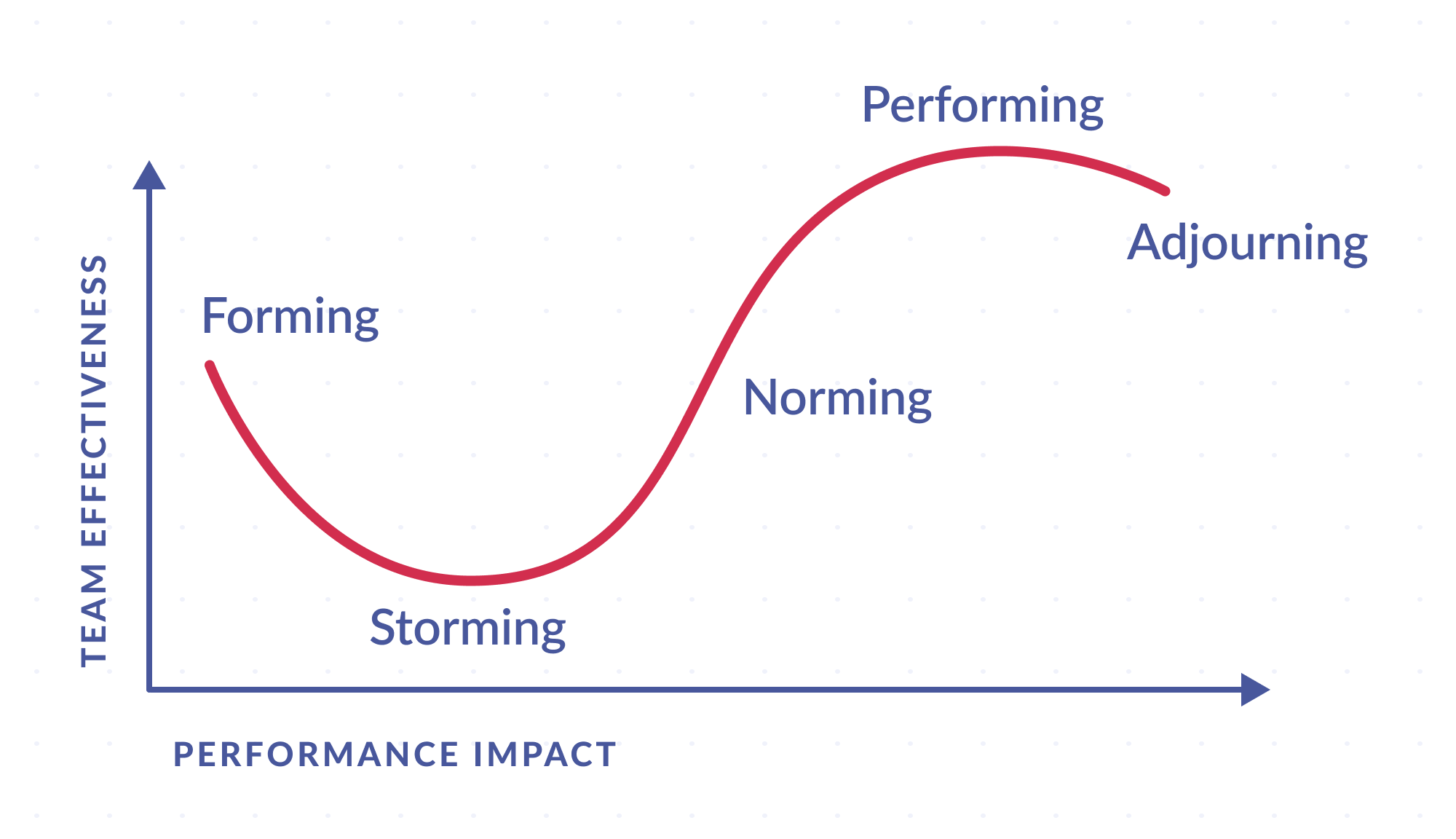Perhaps, in some ideal world, perfect teams gather naturally. In our reality, team development is a multistep process that requires particular actions of the leader at every stage and specific tools to streamline the process.
In 1965, Bruce Tuckman identified 5 stages of team development: forming, storming, norming, performing, and adjourning.

However hard you try to create a healthy working atmosphere, your group will still go through these typical stages and face friction and conflicts at a certain time.
So, the key to maximizing the team’s efficiency is to know at what stage you are now and anticipate the challenges that can soon arise.
Without further ado, let’s explore the changes happening to a group day after day.
What are the five stages of team development?
Forming

What is happening?
A team lifecycle starts with the Forming stage. All members do not know each other well yet, so they are trying to showcase their best traits and winning skills and hide the negative side of their personalities.
It is the time when members get acquainted with each other. Although employees are now interested in new contacts more than ever, the leader should still develop a healthy climate in the group and drive the process via team buildings.
At the start, formalities take up too much time, so the group’s efficiency is quite low. Today many leaders equip their teams with custom or platform-based collaboration tools, like Sharepoint and Office 365, or Salesforce, to facilitate communication and idea exchange. Still, remember that this is a business-critical decision as no software is equally perfect for all teams.
How can leaders ensure success?
At this stage, the leader’s key task is to show the authority that other members are waiting for and formulate the rules of the game. The leader should ensure that everyone sees and understands the big picture; otherwise, employees will focus on their tasks, and the team will never gain synergy.
If the team uses particular tools, the leader should check that everyone knows how to use it and when. Proper training, in the beginning, can save the team a lot of time later.
Takeaways
The Forming team development stage is about setting goals, timeframes, as well as defining responsibilities and norms. By the end of Forming, everyone should clearly understand their roles and know how to contribute to the project’s success.
Storming

What is happening?
Similar to personal relationships, member collaboration also faces the first crisis soon after the beginning. At the second team development stage, the excitement related to starting a new project and meeting people dies down. Now the daily routine comes.
As the team members start feeling more relaxed, their behavior changes. Some people can even show their bad temper from time to time, which can lead to growing irritation and even conflicts in everyday contexts.
The working process itself also suffers from fluctuations. Some individuals can question the defined mission and goals or express an alternative vision of their tasks and responsibilities.
How can leaders ensure success?
The Storming stage is a challenge for the leader. Other members can express their doubts about the leader’s authority and decisions. That is why it is crucial to deal with all conflicts and problems that emerge at this stage. The leader should listen carefully to all the critics and suggestions however strange or ludicrous they seem at a glance.
Rember that disagreement is normal and can actually help to polish the action plan if some of the members come up with indeed sound ideas.
As a leader, explain the key points and plans to settle down all misunderstandings in the team. Use psychology to resolve friction and help employees accept each other.
Takeaways
The competition and conflicts at the Storming stage don’t let the group reach its maximum efficiency. Still, this doesn’t mean that ignoring or prohibiting and disagreement will work. An attempt to neglect the roots of the problem can hamper the successful performance of the whole team in the future.
Norming

What is happening?
The crisis is over, and the group cohesiveness arises. People learn to work with each other and are about to reach their highest productivity as a unity.
All members know where they stand and acknowledge their duties. The established relationships between members help the team achieve a synergistic effect and produce more than they could as individuals.
Experience and competencies now outweigh personal negative and positive attitude, so everyone can contribute to the success of the team with their professional strength.
How can leaders ensure success?
The leader should focus on monitoring and support. Depending on the skills of your team and the needed level of guidance, decide how often you want to check the achieved progress.
Perhaps, you will want to track the group’s performance weekly or once they achieve particular goals. Don’t forget to give constructive feedback. While criticism can confuse some leaders, it helps employees grow. Suggest the ways of improvement to your team members and ask for feedback yourself.
Takeaways
Norming is the team development stage when the hidden conflicts can emerge and hinder the group’s performance. If you tried to close your eyes to any problem at the previous step, now you will have to take matters seriously. Otherwise, the group will return to the second team development stage — storming. Norming is a critical stage. The teams that can’t resolve all their conflicts at this step are unlikely to achieve their goals.
Performing

What is happening?
Good news for those who have overcome all the conflicts and disputes: during the performing stage, the team finally reaches the top of their capacity and can work without a constant intervention of the manager.
How can leaders ensure success?
The team leader should maintain the group’s productivity through checking updates and removing communication barriers if they arise.
Takeaways
Though the team is now working together towards the desired goal, they can still need the leader to resolve some minor disputes quickly.
Adjourning

What is happening?
It is the last of the team development stages. All the project hassle is over. The group has achieved the project goals, and now it is high time to analyze the outcomes.
Many people become quite close after they go through wins and losses together.
How can leaders ensure success?
The leader can mitigate negative feelings of the project ending by organizing a meetup at which they can draw the bottom line, recognize and reward the progress and success. If there is another project, the leader can choose some of the members for the new team.
Why should leaders care about these stages?

The understanding of five stages of team development helps leaders better manage the group and quickly remove bottlenecks that limit the overall capacity.
From the start, the leader should develop behavioral norms and relationships that grow team cohesiveness or the overall motivation to work as a whole.
The more time the group members spend together, the closer they become, the easier they cope with daily workplace challenges. So, don’t underestimate team buildings.
As today the workplace has become digital, the leader has one more important task to consider: Does the used software boost or impede the team’s performance? While initially designed to speed up daily tasks and support workflows, inconvenient tools can make employees do unnecessary jobs and even spoil collaboration. So make sure you pick well-performing software and train all the group members to use it to the maximum.
We hope these tips helped you dive into the team development theory. Feel free to comment below!





